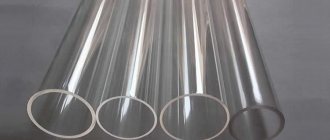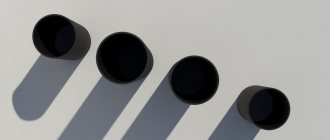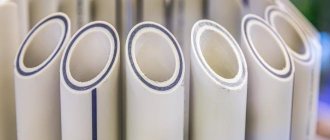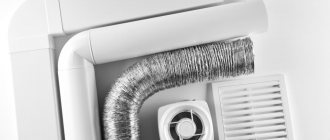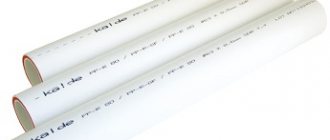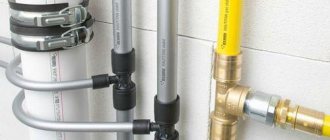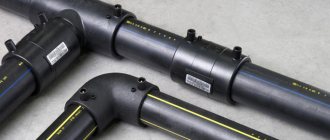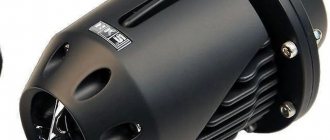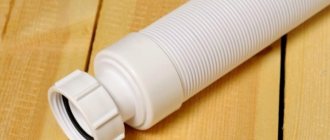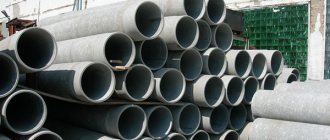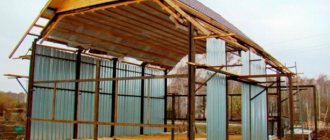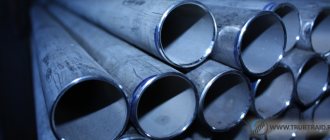MirRtiProf sells transparent PVC tubes in a full range of sizes at low prices. The products are resistant to humid, acidic environments and vegetable fats.
Other advantages of PVC pipes include:
- low price;
- hygiene;
- mechanical strength;
- easy installation/disassembly: due to flexibility, transparency;
- heat resistance: can be used at temperatures from –30 to 80⁰С;
- ability to be spliced using connectors with a transition from one diameter to another.
Technical and operational characteristics and objective advantages determine the demand for colorless plastic tubes in the food industry and during electrical installation work.
Characteristics
The performance of transparent polymers is higher than that of glass. One of them is elasticity, although there are also fragile transparent plastic materials. But first things first.
Strength
The strength indicators of PVC pipes depend on their purpose. Transparent pipes are not used in pressure systems and are not designed to resist internal pressure. But they are resistant to mechanical stress and stretching.
Their hardness and tendency to scratch are low; such pipes require a protective layer. This is almost the only factor in the “disadvantages” column. Their many advantages and the fact that they are impact-resistant expand the scope of application of plastic transparent pipes.
Light transmittance
Products made of transparent plastic have high light transmittance - slightly lower than glass. It can reach up to 92%, and the transmission of ultraviolet rays up to 73%. With special coating, transparent plastic blocks ultraviolet radiation.
Resistance to external factors
Transparent plastic material has low water absorption. Resistant to penetration of odors and biological microorganisms. Mold and bacteria do not grow on a plastic pipe, and fungi do not take root.
Withstands prolonged exposure to temperatures not exceeding +60 ˚С, although it begins to lose properties already at +40 ˚С. The melting point of transparent plastic is 160˚C, fire can start at 260˚C. It burns reluctantly and releases methyl methacrylate when burned.
Chemical inertness
The transparent plastic pipe is resistant to many acids and alkalis. But it can be damaged by hydrochloric and concentrated nitric acids. Hydrofluoric acid in diluted form is also dangerous. Plastic can be dissolved in chlorinated hydrocarbons, acetone, and alcohols.
The high inertness of transparent plastic material to hydrocarbons, oils, and fats makes it often used in the food and medical industries.
PVC pipes (polyvinyl chloride)
The Matins Group of Companies produces PVC pipes that are used in the food, pharmaceutical, medical industries and other industries.PVC tubes are also used as additional electrical insulation of current-carrying elements of various electrical devices operating at voltages up to 1000 V DC and AC with a frequency of up to 50 Hz.
Application of PVC pipes in medicine
PVC medical tube is used in blood transfusion and collection systems, in devices and devices that work in contact with blood, blood substitutes, and physiological solutions. Also used for catheterization, probing and drainage.
Application of PVC pipes in the food industry
In the food industry, PVC tubes are used for non-pressure transportation of gaseous, liquid, and bulk substances, including food products: milk and dairy products, vegetable oil, distilled, carbonated, mineral water, fruit juices, wine, alcoholic beverages, vinegar, etc. d.
In addition, the tubes have limited resistance to vegetable oils and fats.
The transparency of the material allows for visual control of the liquids inside, and the ability to connect the tubes through connectors with tubes of various diameters significantly simplifies the installation and installation of the tubes.
The tubes are made of transparent PVC plastic with an internal diameter from 2 mm to 38 mm and a wall thickness from 0.5 to 5 mm.
A wide temperature range from -30 oC to +80 oC allows the tubes to be used in freezers.
With prolonged contact with water, polyvinyl chloride loses its elasticity, because water washes away the plasticizer and the service life of the tubes, with constant contact with water, is reduced to 1 year. Advantages of PVC pipes - low price
Application of PVC pipes as electrical insulation
The PVC tube is made of modern material - polyvinyl chloride, the inner and outer surfaces of the tube are smooth.
PVC tubes are used as additional electrical insulation of current-carrying elements of various electrical devices and electrical installation work. The tube can be used for open (on walls, ceilings) and hidden (in walls, in ceilings) wiring made of combustible and non-combustible materials. Non-flammable, self-extinguishing PVC material eliminates the possibility of fire from a short circuit and the spread of flame through a pipe or cable.
The tube is used as additional insulation of wires and cables at voltages up to 1000 V DC and AC with a frequency of up to 50 Hz.
Physical and mechanical properties of PVC hoses and tubes.
| The name of indicators | Standards for PVC pipe |
| Tensile strength | 14.1 MPa, (145 kgf/cm) |
| Elongation at break | 250% |
| Transparency in the visible spectrum | 80% |
| Brittleness temperature, frost resistance | -30oС |
Catalog of manufactured PVC hoses and tubes
| Dimensions D (inner diameter) x B (wall thickness), mm | Quantity per bay (m) |
| 2.0 x 2.0 | 500 |
| 3.0 x 1.0 | 800 |
| 3.0 x 2.0 | 500 |
| 4.0 x 1.0 | 800 |
| 4.0 x 1.5 | 500 |
| 5.0 x 1.3 | 500 |
| 5.0 x 1.5 | 500 |
| 6.0 x 1.0 | 500 |
| 6.0 x 1.5 | 300 |
| 6.0 x 2.0 | 250 |
| 7.0 x 1.0 | 500 |
| 7.0 x 1.5 | 300 |
| 7.6 x 1.2 | 300 |
| 8.0 x 1.0 | 400 |
| 8.0 x 1.5 | 300 |
| 8.0 x 1.8 | 200 |
| 8.0 x 2.0 | 200 |
| 10.0 x 1.0 | 300 |
| 10.0 x 2.0 | 150 |
| 12.0 x 2.0 | 150 |
| 14.0 x 1.5 | 150 |
| 14.0 x 2.0 | 150 |
| 14.0 x 5.0 | 50 |
| 15.0 x 2.0 | 150 |
| 16.0 x 1.8 | 100 |
| 16.0 x 2.0 | 100 |
| 18.0 x 1.8 | 100 |
| 18.0 x 2.0 | 100 |
| 18.0 x 2.75 | 50, 100 |
| 19.0 x 5.0 | 50 |
| 20.0 x 2.0 | 100 |
| 20.0 x 2.5 | 100 |
| 20.0 x 3.0 | 50, 100 |
| 20.0 x 6.0 | 30 |
| 24.0 x 6.0 | 30 |
| 25.0 x 3.0 | 50 |
| 25.0 x 3.5 | 50 |
| 25.0 x 4.0 | 50 |
| 30.0 x 5.0 | 30 |
| 32.0 x 5.0 | 30 |
| 38.0 x 5.0 | 30 |
Placing an order
When ordering, you must indicate the inner diameter of the tube, wall thickness, number of coils or footage, and purpose. If there are special conditions (for example, high blood pressure), be sure to note this when filling out the application.
Application example: PVC tube 8x1.5 in the amount of 1 coil (300 m) for non-pressure transportation of juice
, which means a PVC tube with an internal diameter of 8mm, a wall thickness of 1.5mm, an external diameter of 11mm with food grade approval.
Areas of application
The low cost and ease of processing, resistance to corrosion and aging of the material makes it applicable in many areas. Transparent pipelines are used in robotics, where plastic pipes are a kind of “plumbing” for colored liquids. And with the development of LED technology, where the light source hardly heats up, they are becoming widely used in garlands of advertising equipment.
Lighting devices
Due to the ability of transparent plastic pipes to diffuse light and transmit it highly, they are widely used in lamps, table lamps, lanterns and neon lighting.
Interior design
The widest use of transparent plastic pipes is in repair and design. Thanks to multi-colored LEDs, pipes are used to illuminate design elements in the interior of buildings and premises.
Advertising signs and colorful decoration of building facades are rarely complete without transparent plastic.
Electronics and computer industry
A transparent plastic tube is often used as a cambric. This is an elastic fragment that is put on the wires at the point of contact or soldering for insulation. Its transparency allows the service operator to evaluate the contact connection when inspecting and regulating electronic equipment.
The described material is used in various electronic computer devices that deal with liquids. For example, liquid analyzers, synthesizers, 3D printers.
Use of PVC pipes in food production
In confectionery factories, enterprises specializing in the production of oils, fats, cheeses, dairy products; drinks, including alcoholic; vinegar, sausages, ketchups, there is a need to transport liquid, bulk, creamy products. Durable transparent PVC tubes are indispensable in such industries. They provide transportation of ingredients, water to mixers, dough mixers, cooking kettles, and to the bottling site.
Transparent walls provide visual control of the contents, operation of pipelines, and their technical condition. The polyvinyl chloride used in the production of tubes is adapted to low and high temperatures, so PVC tubes can be used in freezers for transporting cold and hot products.
What materials is it made from?
The properties of plastic pipes directly depend on the material from which they are made. Although sometimes you can’t tell them apart by appearance, the difference in characteristics is noticeable. Therefore, I propose to consider the properties of polymers.
Polycarbonate
This is a lightweight and durable material. Its specific gravity is 1200 kg/m³, which is 2.5 times lighter than glass. Polycarbonate is easy to process; it can be cut, drilled, sharpened, and polished. It will not crack even if you screw a self-tapping screw into it. Another advantage is fire safety.
Polymethylmethacrylate, or plexiglass
It is called PMMA for short, or plexiglass. The second name appeared due to the high light transmittance - up to 0.92. For ordinary glass, this coefficient ranges from 0.9 to 0.85, so plastic even surpasses it. The impact strength is 5 times higher, the specific gravity is 2.5 times lower than glass. But even when broken, plexiglass does not pose as much danger as glass.
Polyvinyl chloride
It is a soft and flexible material that is inferior in strength to all other transparent plastic substances. And although it has a small range of operating temperatures, from – 15 ˚С to + 60 ˚С, it is very widespread.
The disadvantages of this material are the destructive effects of ultraviolet rays on it. This limits its use outside buildings, where, in addition to ultraviolet radiation, there may be a temperature below - 15 ˚С, which also has a detrimental effect on it.
Production technology
Clear plastic pipes are made in two main ways: casting and extrusion. The press uses pressure to force out plastic material heated to the point of melting. Special holes allow the pipe to be formed at the initial stage. Next, the device pulls out the cooled part of the pipe.
This method allows you to make long pipes, and if the material is flexible, then wind it into rolls. For example, PVC pipes are manufactured and wound into coils, where the length of the pipes is kilometers.
Pipe casting using the seamless method is carried out using special centrifuges. The molten material fills the mold, which rotates at a certain speed. Centrifugal force evenly distributes the molten polymer before it cools, forming a pipe of the desired diameter.
Installation features
When arranging illumination, decorative and functional pipelines, and aqua panels, transparent plastic pipes are subject to the same manipulations as opaque polymer pipes. However, there are nuances that are characteristic specifically for products capable of transmitting light, because it is important to preserve the aesthetics and transparency of the pipes:
- To cut polycarbonate and acrylic, use a saw or hacksaw; PVC pipes are cut with a metal hacksaw or pipe cutter.
- Holes in transparent pipes can be melted, but in this case a sagging will form around them - burr, which must be removed, in addition, the plastic darkens near places of strong heating. It is preferable to drill holes with a drill or screwdriver.
- To connect the sections, fittings made of the same material as the pipes are used.
- Before connecting pipeline elements, the sections are cleaned, polished and degreased.
Important! When using transparent plastic to make lamps, garlands, and illumination, it is necessary to dry the pipes from the inside - this will prevent fogging and loss of transparency during operation.
- Polyvinyl chloride pipes are bent without additional processing by hand. Polycarbonate is preheated to 120 degrees, and plexiglass to 150-180, and carefully bent using a manual spring bender or a metal rod that serves to stabilize the pipe. The use of a stabilizing element is necessary to distribute the stress that occurs in the walls of the pipe when it is bent. This will help maintain uniform transparency and prevent cracks from appearing.
Important! You can bend the pipes by pouring sand inside and only then heating them - the sand will stabilize the walls and prevent them from bursting. However, in this case, it is important to rinse and dry the pipes from the inside after finishing the work.
- Fixation of transparent pipes is carried out using clamps and hangers, which allow you to securely fix the position of the pipeline element, or hooks and clips that hold the pipes without spoiling their appearance.
Advantages and disadvantages
The only competitor to transparent plastic pipes is glass: in terms of mechanical and chemical properties, plastic products are not inferior to it. And in the field of design they even compete with crystal. In any case, products that imitate crystal benefit in price.
According to its physical characteristics, plastic has the following advantages:
- Not fragile. Even when some of its types crack, they do not form dangerous fragments.
- Easy. The specific gravity is significantly higher than glass.
- Relatively cheap.
Flaws:
- Small temperature range.
- The material is scratched.
- Some species may fade, turn yellow or become cloudy, or crumble when exposed to the environment.
How to choose
When choosing pipes, it is necessary to take into account their characteristics. These are temperature range, strength, impact resistance, flexibility and crackability.
If the plastic material requires further processing, then it is better to use polycarbonate. And if you just need decorative transparent pipes indoors, then use polyvinyl chloride. If the temperature range does not allow its use, then plexiglass is chosen.
The manufacturer is also important. Nowadays, a branded product does not mean expensive. It’s just that branded manufacturers produce their products on high-tech equipment using innovative technologies. It can even reduce the cost of the product while increasing its quality. Qingdao Eastop Plastic, Hebei Orient Rubber & Plastic, Borrex, Sotalight, SUNNEX have a good reputation.
